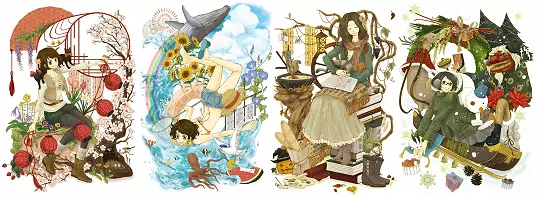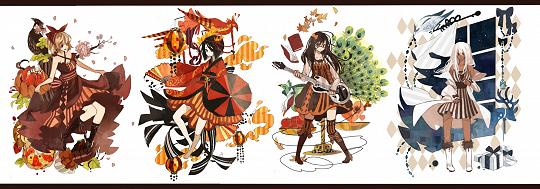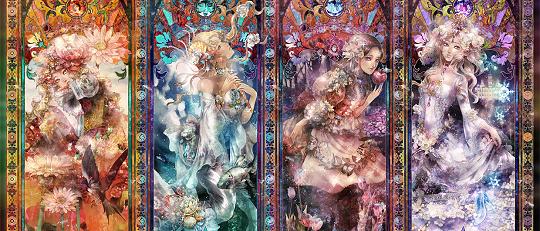Image by maru (memoriatechnica) [Pixiv]
It’s only recently that I’ve started to believe that “cour” is in fact a word and not just a misspelling of “cur” (as in “that cur of a cour”). As it’s entered into the lexicon of anime over the past couple of years (AnimeNano puts its first use in English around 2011) it has become an easy shorthand for how long an anime series will run for. That word “series” ends up being problematic because - for me at least - it can now mean a whole multitude of things, thanks primarily to the introduction of “split cours”.
As Wikipedia informs me, referring to a television broadcast (internet streaming simulcast etc.) as a “series” is a chiefly British use of the term, and in North America the more common term is “season”. “Season” works better when referring to something like anime because apart from a select few (One Piece et. al.), they can be measured in seasons i.e. winter, summer etc. and substituting “season” for “cour” isn’t exactly complex. However, semantically a problem arises when, as is becoming increasingly common, an anime runs for one season, lies fallow, and then finishes in another. The split cour.
From a production point of view I think Ask John’s article on it from 2012 does an excellent job of postulating the reasons companies and creatives do it and, even now two years later, very little of it can be refuted. The niggling issue I have with split cour shows is neither lexical nor material but emotional.
I watch anime for a lot of different reasons but one of them is for the story. As one book that I’ve read elaborated on (I wish I could remember which one, probably Dogs and Demons though there’s no e-book version to verify), Eastern stories tend to have a few core narratives told many different ways, while Western stories the opposite. It’s a massive generalisation of course but from the blinkered point-of-view anime offers, it’s difficult to repudiate. What’s rewarding for me however is having an anime finish broadcasting, and then be done. No more. Because it means I can start on something new.
Sure there are sequels and depending on the source material used they can either be welcomed or dreaded. But the point is that sequels are additional, regardless of their quality or the team that produces them, one thing has finished (e.g. Gunslinger Girl) and the next one is, for better or worse, logically separate (e.g. Gunslinger Girl Il Teatrino). Splitting the broadcast of an anime becomes problematic for me because I can’t formulate any concrete thoughts on it - more is coming after all. It’s just coming in thirteen weeks so now I have all this time to muse over whether I want it to come back or not.
Image by kotatsu / anbiravens [Pixiv]
This is complicated by the practice of narratively making the first cour a complete arc, climax, denouement and all; so like finishing a particularly grueling section of a video game, there needs to be an impetus, and most crucially the will, to carry on. In this regard both split cour and sequels do this in exactly the same way: more.
More characters, more action, more silliness, more panty shots. Take the sequel to Durarara for instance. The first series wasn’t exactly light on characters, but now in this second outing the opening is wall-to-wall character intros. Or Tokyo Ghoul Root A - who the hell are those chaps and why is Kaneki siding with them? Or Aldnoah Zero - oh good another princess and the resurrection of characters who should be dead.
Those are just illustrations of my core point though which is fundamental to the idea of split cours and sequels in general: more is very rarely better. That may sound like me throwing my toys out of the pram because Mushishi got a sequel, and I loved that to bits. But. I would have been just as happy without it, and in a way I would be happier without a lot of the second cours and sequels that have come out. Chaika? Illya Zwei (which itself is getting a second cour). The endless Monogatari saga. Sword Art Online.
Introducing a split or adding a sequel incurs the same penalty: you inevitably dilute the original product (the first cour, the first series whatever) regardless of its treatment because the separation makes it the first rather than the start. Durarara was fine in 2010, but now four years later, the characters in the show have only progressed 6 months (or not at all if you listen to Mikado) so there’s familiarity but for a time that has inextricably passed. And if anything I watch anime for the unfamiliar, the unknown and the downright bizarre that is diametrically opposed by sequels and split cours.
It’s a common complaint that the overrated shows, the Sword Art Onlines, the Shingeki no Kyoujins and the like get more while the underrated gems like Nozaki-kun or Hataraku Maou-sama are somehow relegated to a paltry one cour. Don’t get me wrong, I would love more of both of them, but only in concept. Perhaps that’s a criticism of the implementation rather than the nature of sequels and split cours, and more anime doing so will balance the scales (Fate/stay night UBW has a good chance with this).
Don’t get me wrong, this isn’t an echo of the common cry about Hollywood movies nowadays - it’s all sequels and franchises! Just scanning through the past year there has been plenty of superb one cour shows. For now. It’s just another slightly whiny data point in the cloud of general unease about anime at any given time, for now it seems to be risk aversion which, if splitting broadcast can in any way alleviate, I’ll suck it up and have nothing more to say on the matter, even if only announcing how long a series is after you’re sure it’s doing well seems ridiculously sneaky.
Take this more as a note of concern then. Reflections on my disconcertion when I sat down with the latest season’s batch of first episodes and felt only familiarity; but then the choice to watch what I knew - if only out of morbid curiosity - was my own. I wonder though whether fatigue will set in for productions like the Durarara sequel with its practically unheard of three (split) cour broadcast. For now though, this is little more than a declaration that I’m going to use “series” to cover all the cours an anime broadcasts over (Fate/stay night UBW as a series), and “season” to cover just that cour. I might throw “show” and “production” in there just to mess things up as well though.



The issue here isn't so much about sequels (which seems to be what you are really complaining about) or split cours, but the problems and limitations of serial broadcasting in general. If you don't like how a story sits in your head every week, and I think most would agree there are some shows that are more set up for marathoning than others, you certainly do not have to engage the material like a weekly circus.
The Ask John post doesn't harp on the number one reason to split cour productions: production and scheduling benefits. The whole "second season option" thing is more like a nuclear option, as broadcast slots tend to be set up 9-12 months ahead of time. It does happen from time to time, but it's exceedingly rare that a show gets "cancelled" out of a split cour (usually it's done to make way for something else, or out of contractual issues: see Galilei Donna, Wolf's Rain). It's more because the production pipeline can't handle the show and maintain a certain level of quality. This is notoriously why Fate/Zero and Fate/stay night UBW is getting that treatment.
None of which IMO is out of a narrative response. I think instead of Aldnoah.Zero it's better to examine Psycho-Pass, as far as a matter of a concern of serial continuity. Plus that one is already done.